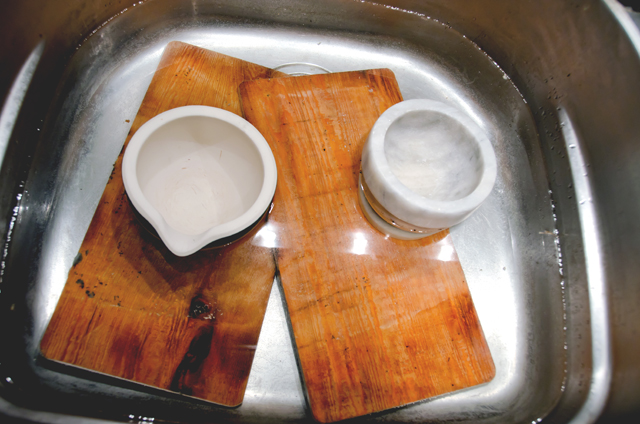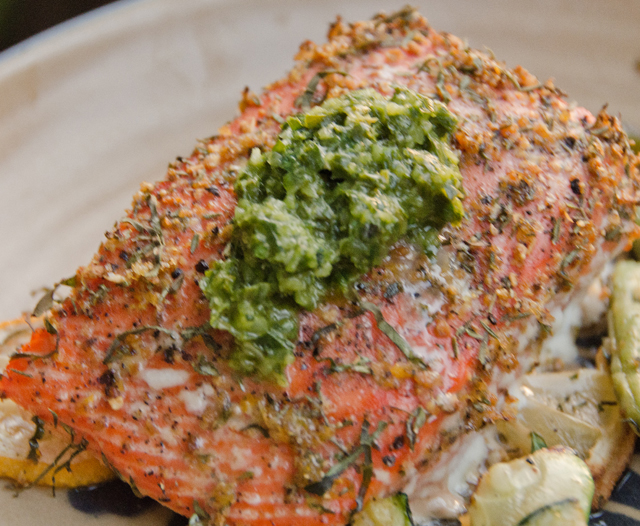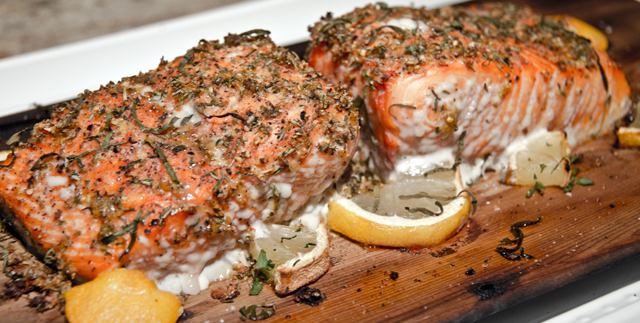Getting my husband to try new cooking techniques isn’t always the easiest thing to do. If I can convince him to try something new once and then he embraces it, I know I have found something worthwhile. The convincing was easy with the rib roast cooked like a steak. I just showed him the YouTube video of chef-author Adam Perry Lang cooking it on the Jimmy Kimmel program. What guy (or gal for that matter..) could resist pounding a rib roast with a baseball bat to increase the cooking surface area of the meat? It was a big hit at our house this summer and successfully repeated a few weeks ago.
Last summer I wanted to try cooking salmon on cedar planks. Since we love the flavor that a wood fire brings when we cook turkey or chicken on our outdoor smoker, why not infuse some cedar smoke into some delicious salmon fillets? I bought the planks, introduced him to the concept and recipe and we were cooking.
Cooking on wood planks certainly isn’t new. It is a technique that was pioneered by Native Americans who roasted both fish and game on aromatic cedar planks. Cedar planks are available everywhere these days from supermarkets to specialty cooking stores. Just be certain not to buy planks that have been treated with chemicals, like those from a home improvement store. Your planks will need to be soaked before using for several hours or overnight so they don’t burn on the grill. Some recipes soak the planks in cider, wine or sake, but that could be an expensive proposition considering the amount of liquid needed to submerge the planks. I soak my planks in one of our sinks using heavy marble and ceramic mortars to weigh them down.
We chose Copper river salmon, which is available fresh from May to September. As with all salmon, Copper river is loaded with Omega 3 oils and recommended by the American Heart Association. Omega 3 oils help reduce heart disease and lower cholesterol. I season my fish with a dry rub before grilling to enhance the flavor. Cedar planked salmon is excellent on its own with a squeeze of lemon or served with a sauce. I have served it with both a horseradish sour cream sauce and herbed salsa verde. What is the white stuff that your salmon may exude? Protein, albumin to be exact. It occurs more often in salmon with a high fat content. It is definitely safe to eat but can be wiped off for aesthetic reasons.
Cedar planks can be reused. Wash the used planks with warm water, clean off any debris with a soft bristle brush and allow to air dry. Don’t use soap because the board may absorb it and affect the flavor it gives off. I wrap my used planks in plastic wrap and store them in the freezer. Don’t reuse if the planks are excessively charred, cracked or split.

Cedar Planked Salmon
Serves four
Ingredients
Salmon Rub
- 1 Tbs. grated lemon zest, minced
- 1T dried lemon peel
- 1 1/2tsp. chopped fresh thyme
- 1 tsp. granulated or brown sugar
- 1/8t cayenne pepper
- Kosher salt and freshly ground black pepper
- About 1/2c lemon basil cut in a chiffonade
- 1 1/2 to 2lbs salmon filets cut into 6-8oz portions, skin on and pin bones removed
- 1-2 T olive oil
- 1 lemon, cut into thin slices
- Food safe cedar planks

Directions
Cedar Planks
Soak the cedar planks in water to cover for at least two hours and up to overnight. Drain the planks.
Salmon preparation
- In a small bowl, with a fork, combine the fresh and dried lemon zest, thyme, sugar, cayenne pepper, 1 1/2 tsp. salt, and 1 Tbs. pepper. Rub the salmon fillets on both sides with olive oil and then set each fillet portion skin side down on the planks.
- Sprinkle the fillets with the lemon herb mixture, dividing it evenly. Gently rub the seasoning into the fillets. Sprinkle the chiffonade of lemon basil over the fish. Place the lemon slices around the fish. Let stand at room temperature while the grill heats.
- Prepare a gas or charcoal grill fire for indirect cooking with high heat: On a gas grill, heat all burners on high; then turn off all but one burner just before cooking the salmon; on a charcoal grill, bank the coals to two opposite sides of the grill. Arrange the planks over the cooler part of the grill, positioning them so that the thickest part of the fish is closest to the heat source. Allow space between the planks to allow heat and air to flow. Cover the grill and cook until the thickest part of each fillet registers about 135°F on an instant-read thermometer, 20 to 35 minutes depending on the thickness of the fillets. The planks may smoke a bit (this is fine) and will become very aromatic.
- Fillets should rest on the planks for 5 to 10 minutes before serving. Serve as is or with the sauce of your choice.

Salmon served with an herbed salsa verde and wax beans from the garden.
